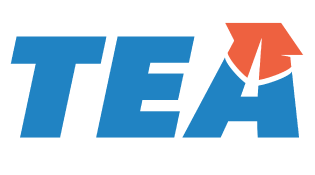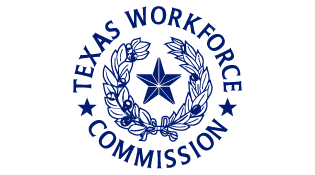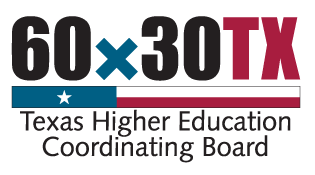Taking a holistic look at our Texas school districts to determine how we can influence college, career, and military readiness (CCMR) is more important this school year than ever. During this professional development webinar, we show how districts around Texas are improving CCMR using Texas OnCourse. In this webinar, you’ll:
- Hear an accountability update from TEA
- Hear from colleagues in districts all over the state about what’s working
- Learn best practices and strategies to implement in the 2021–2022 school year
For more information on postsecondary pathways and guiding your students toward bright futures, visit the Texas OnCourse Academy.
View the webinar and slides below, or continue reading for highlights and resources from the webinar.
2020-2021 Accountability System Update
First, we heard from Heather Smalley at the performance reporting division of the Texas Education Agency. She shared accountability rating system updates. TEA has released the 2021 Academic Accountability Framework. See it on the 2021 Accountability Development page. The framework summarizes the commissioner’s final decisions on 2021 state accountability. For frequently asked questions, please consult the 2021 Academic Accountability Framework FAQ document. As noted in the December 10, 2020 To The Administrator Addressed, TEA will process and report all available data from the 2020–21 school year. Here are the scoring conventions for the 2020–21 school year:
- No overall or domain scaled scores or A–F ratings.
- All districts and campuses will be labeled Not Rated: Declared State of Disaster.
- All data will be report only.
- Raw domain scores will not be displayed.
- Raw component scores will be displayed.
Here is an example of how the score reports will look different between 2019 (left side) and 2020 (right side):
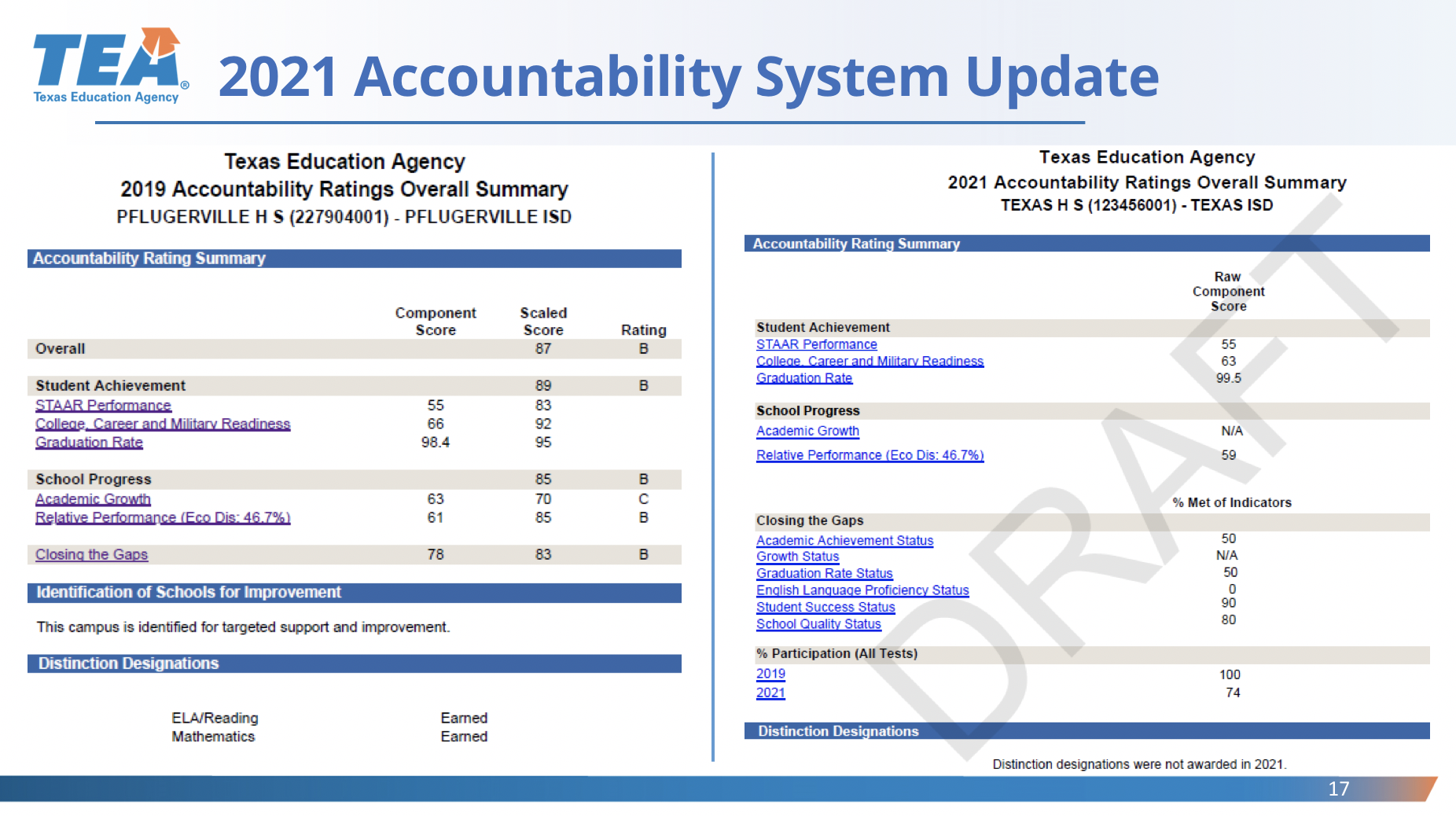
Military Enlistment Data
Military enlistment data will be excluded from accountability calculations until it can be obtained directly from the US armed forces. This is due to discrepancies between annual enlistment counts released by the Department of Defense and TSDS PEIMS military enlistment data. Additionally, the one-half point awarded to graduates completing and receiving credit for at least one CTE course aligned with an industry-based certification has been phased out.
Report Release Information
- TXschools.gov and TEA’s 2021 accountability page will release masked accountability reports.
- The TEA Login (TEAL) Accountability application will release unmasked accountability reports and confidential student listings to districts in August.
- Performance Reporting will have access to attendance data in fall 2021. Additional COVID impact on student-level outcomes will be analyzed and shared during winter 2021.
- The 2021 Accountability Manual will be posted to the Performance Reporting and the Texas Register websites in April.
CCMR Tracker
We learned about a new tool called the CCMR Tracker. It’s free and available to all districts through the TEAL Accountability application. It’s intended to help ensure that every student is prepared for college, a career, or the military by graduation. The CCMR Tracker provides districts with an early preview of the CCMR status for students reported as enrolled in grades 9–12 on the TSDS PEIMS October 2020 snapshot date (school year 2020–21). A major benefit? Districts can use the CCMR Tracker to plan for TSDS PEIMS reporting and ensure that students will meet CCMR criteria before graduation. The 2021 CCMR Tracker will be released in two stages this year:
- March 31: CCMR outcomes as reported though TSDS PEIMS, for TSIA results, and for OnRamps course completion through the 2019–20 school year
- July 2021: CCMR outcomes for SAT, ACT, AP, IB, and level I/II certificates through the 2019–20 school year.
Need-to-Knows about the Tracker
- Districts get a student-level view of CCMR data that TEA has received from TSDS PEIMS submissions and non-PEIMS sources (SAT, ACT, TSIA, etc.). The data lags.
- No corrections will be submitted to TEA; this report is for informational purposes only.
- If districts find errors with testing-related indicators, they should work with testing vendors to make corrections before the student’s graduation. TSDS PEIMS data are final.
A video walkthrough of the 2020 CCMR Tracker is available here. The Performance Reporting Resources site will post an updated video walkthrough of the 2021 CCMR Tracker along with additional resources.
The CCMR Verifier
We also heard updates on the CCMR Verifier. The CCMR Verifier will be available in late May. It’s the same online system as last year’s, which ran from August through October. The Verifier contains 2019–20 annual graduates plus 12th graders who did not graduate. Corrections may be submitted through the TEAL Accountability application for the listed students. The Verifier can only be used to correct non-PEIMS indicators. TSDS PEIMS data are final. If the district does not find any discrepancies or wish to request changes, no action is required. If discrepancies are found, districts must request changes with supporting documentation. With this in mind, districts are encouraged to verify their CCMR data to ensure accurate data for:
- The CCMR Outcomes Bonus
- Potential future small numbers analyses
- The 2020–21 Texas Academic Performance Report (TAPR)
- Potential use in future accountability ratings
Please note: CCMR indicators determined by TSDS PEIMS submissions are not eligible for corrections and therefore are not shown. More information on the CCMR Verifier will be posted this spring. Please subscribe to the Performance Reporting Weekly Bulletin for updates.
The CCMR Outcomes Bonus
As part of House Bill 3, the agency awards CCMR Outcomes Bonus (CCMR OB) funding to districts every year. It’s based on the number of annual graduates who demonstrate CCMR above a threshold for three cohorts:
- Annual graduates who are educationally disadvantaged (economically disadvantaged)
- Annual graduates who are not educationally disadvantaged
- Annual graduates who are enrolled in a special education program
These threshold percentages are based on statewide CCMR outcomes for each cohort from the 2016–17 school year. The threshold percentages of annual graduates who demonstrate college, career, or military readiness for each of the following cohorts are as follows:
- 11% of annual graduates who are educationally disadvantaged
- 24% of annual graduates who are not educationally disadvantaged
- 0% of annual graduates who are enrolled in a special education program regardless of whether the annual graduates are educationally disadvantaged
CCMR bonuses are paid for each annual graduate above a certain threshold percentage, as follows:
- Economically Disadvantaged: $5,000 for each CCMR economically disadvantaged annual graduate above a threshold
- Not Economically Disadvantaged: $3,000 for each CCMR annual graduate who is not economically disadvantaged above a threshold
- Special Education: $2,000 for each CCMR annual graduate enrolled in special education
Take a look at these helpful charts for CCMR OB methodology:

Helpful Resources
- The CCMR Outcomes Bonus Report provides a history of the bonus and performance overviews of the class of 2018 and the class of 2019.
- Additional CCMR Outcomes Bonus information can be found in the documents below and on the Performance Reporting Resources webpage.
- CCMR Outcomes Bonus Data Sources
- CCMR Outcomes Bonus Data Processing Timeline
- CCMR in Academic Accountability Versus Outcomes Bonuses
District Practices from Jarrell ISD
Next we heard from leader fellow Kaitlyn Watson, who is also a college and career coordinator at Jarrell ISD. She shared the following things her district is doing right now:
- Virtual meetings
- Parent outreach and updates
- Providing updates and opportunities – accessible when ready! Don’t stress on immediate participation!
- Collaboration with others involved, involving teachers and those who are interacting well and often
- Virtual college tours, enrichment opportunities
- Accessible websites with valuable resources
- Check-ins and accessibility
Kaitlyn added that keeping spreadsheets to share updates with her administrative team has been helpful. She also maintains spreadsheets to track student interests, awards, and celebrations to make advising appointments easier. She noted that using sandwich-board style chalk signs outside her office with intentional, creative messaging on topics like scholarships was effective at reaching her students. She shared that she had great success cold-emailing schools for promotional materials like pennants and swag to hand out to students. And certain organizations (like the Army) were willing to talk with students at school in a safe, distanced way. Finally, she mentioned that because her school was spending less on campus visits, those funds were directed toward more CCMR representation on campus. That looked like more posters and school spirit items around the school, and a March Madness promotion across the district. Her school also put on in-person scholarship opportunities and lunches, created a college prep library, and added some high school credit courses to their middle school offerings.
District Practices from Frisco ISD
Next we heard from Dr. Angela Romney at Frisco ISD. Dr. Romney shared that Frisco is a district with about 63,000 students north of Dallas. Some10–15% of students qualify as economically disadvantaged. She shared what the district’s staffing and support structure looks like:
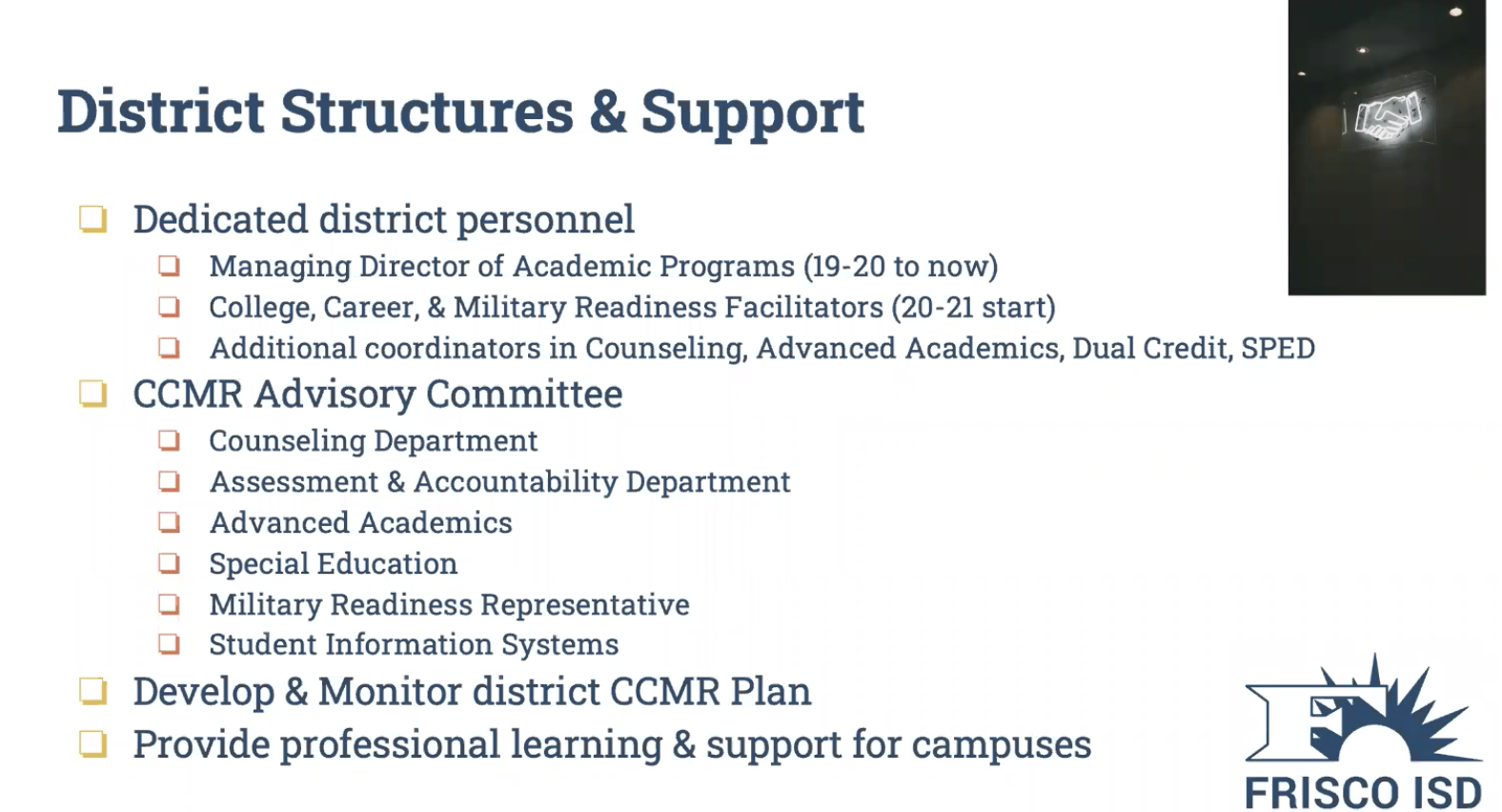
Dr. Romney shared that her district’s overall goal is to increase CCMR from 79% in 2020 to 84% in 2024 with the following strategies:

She also gave the following info about how the district plans to monitor CCMR indicators:

Finally, on a campus level, Dr. Romney recommends that each campus develop specific goals that tie in with district goals and include strategies to meet them.
Goal: Frisco High School will increase Khan Academy enrollment for SAT prep for 11th grade students from XX to 85% by January 2021.
Strategy: During the week of Dec. 14–18th, all 10th and 11th grade English classes will enroll students in Khan Academy during class and link their PSAT scores.
District Practices from Harlingen ISD
Finally, we heard from Crystal Castaneda and Delicia Sanchez, college and career advisers at Harlingen ISD. They shared how they promote a culture of CCMR on their campuses:
- Updating social media and campus websites
- Using the Remind app
- Sending parent emails
- Making presentations/using pre-registration
- Giving yard signs to AP scholars
- Giving high-achieving students recognition at board meetings
- Having festive college and career rooms




